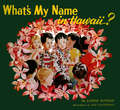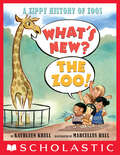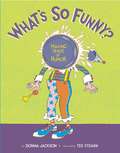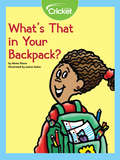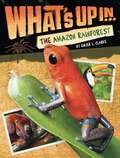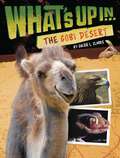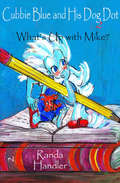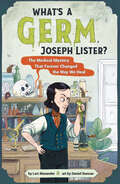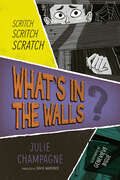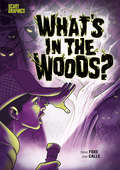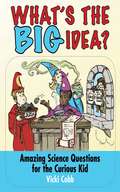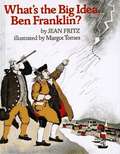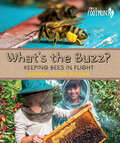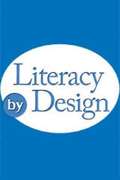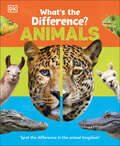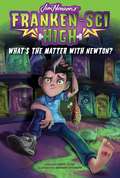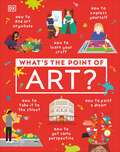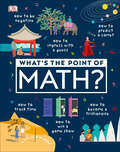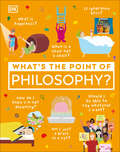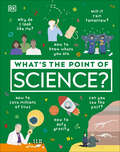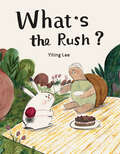- Table View
- List View
What's Faster Than A Speeding Cheetah?
by Robert E. WellsWhat's faster than a cheetah?--no animal on earth can run faster. But a peregrine falcon can swoop faster than a cheetah can run. And the falcon can't compare to an airplane, a rocket, or the speed of light.
What's Faster Than a Speeding Cheetah?
by Robert E WellsWhat's faster than a cheetah?--no animal on earth can run faster. But a peregrine falcon can swoop faster than a cheetah can run. And the falcon can't compare to an airplane, a rocket, or the speed of light. Lively text and watercolors will make children laugh while they learn all about speed.
What's My Name in Hawaii?
by Ray Lanterman Louise BonnerWhat's My Name in Hawaii? is a multicultural children's story of a little Japanese boy's search for a name.He needs a new one because he is about to become an American citizen in Hawaii, where his parents have come to live from faraway Japan.<P><P>When Toshio Takahashi first goes to school he does not want to play with the other children. Like most beginners, he cries because he misses his mother and mostly because he does not speak or understand English. Language, however, proves no barrier in a child's world and soon Toshio is just another flower in the school called Na Lei o Ka Keiki, "a lei of children".When Toshio's citizenship day approaches, all of his young schoolmates wish to help him select an American name like theirs, to add to those reflecting their various racial backgrounds. Susan Iwalani Au suggests "John" and Lisa Ilima Santiago offers "Gaylord" because she has an uncle by that name.The final choice is a happy one for all most of all, to Toshio whose new name now reveals that he was born in Japan, but is an American citizen living in Hawaii, the 50th State of America.
What's New? The Zoo!: A Zippy History of Zoos
by Kathleen KrullWith friendly facts, funny pictures, and animals galore, What's New? The Zoo! is history to roar for!Did you know . . . * The first zoo was established forty-three hundred years ago in what is now Iraq?* Aztec King Moctezuma II had such an incredible collection of animals that it took six hundred men and women to care for them?* Children across Great Britain wrote to Queen Victoria when Jumbo the elephant was sold away from the London Zoo?* Fifty buffalo passed through Grand Central Station in 1907 on their way to the Bronx Zoo?* Zoos now play a crucial role in animal conservation?Kathleen Krull and Marcellus Hall bring witty insight, jazzy style, and a globe-trotting eye to our millennia-long history of keeping animals -- and the ways animals have changed us in turn.
What's Older Than a Giant Tortoise?
by Robert E WellsIf medals were awarded to animals for living a long time, then a giant tortoise would certainly win one. Some giant tortoises have lived for more than 150 years! Still, there are things on this planet much older than giant tortoises. Some of the giant sequoia trees that grow in California would be more than 3,000 years old. But the trees aren't that old compared to the Barringer Crater in Arizona--that was made about 49,000 years ago. And it's almost impossible to imagine that 65 million years ago, the T. rex dinosaur roamed this planet--but we have the skeletons to prove it!
What's Smaller Than a Pygmy Shrew?
by Robert E WellsA pygmy shrew is among the tiniest of mammals. A ladybug is even smaller. But in this book you will find small things you could not ordinarily see.
What's So Funny?
by Donna JacksonEveryone loves to laugh, and to hear and see funny things-but what makes something funny in the first place? What is humor? This book explains why our brains think something is funny, what happens to us physically when we laugh, why you can tickle your friend but not yourself, and so much more. Plenty of jokes and silly anecdotes are included, and hilarious line drawings appear on almost every page.
What's That in Your Backpack?
by Mona PeaseAre you carrying a forest on your back? Of course not! But if you dig through your backpack, you will probably find many things that come from the forest.
What's Up in the Amazon Rainforest (What's Up)
by Ginjer L. ClarkeWhere in the world will you find 427 different types of mammals, 1,294 birds, 2,200 fishes, 378 reptiles, 428 amphibians, and about 1 million insects? The Amazon Rainforest, of course! Get lost in the largest rainforest in the world to climb trees that are 500 years old, swim with a pink dolphin, avoid the deadly poison dart frogs, and sleep with a troop of twenty howler monkeys. In What's Up in the Amazon Rainforest, you'll learn all about the plants and animals, as well as the people that live there and the habitat itself.
What's Up in the Gobi Desert (What's Up)
by Ginjer L. ClarkeExplore the Gobi Desert with the second book in this nonfiction geography series, packed with full-color photographs and a fold-out map! Gobi means "waterless place" - the perfect name for a desert! The Gobi covers parts of northern China and southern Mongolia. But contrary to the typical desert image, only 5% of the Gobi has sand dunes! It is also very cold, with an average temperature of only 37 degrees Fahrenheit for the entire year. Explore the expanse of the Gobi Desert with this fascinating addition to the What's Up series, and discover the wild plants, animals, and people that call this habitat home.
What's Up with Mike?: Cubbie Blue And His Dog Dot Book 2 (Cubbie Blue and His Dog Dot #2)
by Randa HandlerDerek, Chris, and Brian, three seven-year-old boys, befriend Derek's new neighbor, Mike, who is blind. Their special friend, Cubbie Blue, a three-inch-tall being with supernatural powers, and his minuscule dog, Dot, help the boys learn about Mike's limitations and needs. This important knowledge allows them to properly welcome Mike to the neighborhood. In turn, the boys help Cubbie escape from the evil soldiers trying to capture him, and he is saved by their bravery.
What's a Germ, Joseph Lister?: The Medical Mystery That Forever Changed the Way We Heal
by Lori AlexanderThis engrossing, timely, and highly illustrated biography of the father of modern surgery reveals the shocking practices of surgeons before Joseph Lister proved where infections come from.In 1841, a quiet, curious boy who stuttered when nervous committed to becoming a surgeon—a profession then more feared than respected.Through study, persistence, and careful research, Joseph Lister proved that unsanitary conditions contribute to infections. Despite others scoffing at his ideas, Lister slowly changed the way all surgeons work, saving countless lives.Sibert Honor-winner Lori Alexander’s accessible and lively biography of Lister contains fun—and sometimes gory—facts about the history of science and engaging illustrations by Daniel Duncan.
What's in the Walls? (Orca Shivers)
by Julie ChampagneScritch, scratch… One day after floor hockey practice, ten-year-old Zack hears some strange sounds in the school gym. But he's the only one in there. It sounds like scratching...and it's coming from inside the walls. As he investigates, he wonders what could be making the sound. Giant spiders? The ghost of a construction worker buried alive when the school was built? Zack soon discovers that the school custodian has not been doing a good job of keeping the school clean. The epub edition of this title is fully accessible.
What's in the Woods? (Scary Graphics)
by Steve FoxeAndy isn't excited for camp. Things go downhill when the older boys start telling stories of mysterious fairy circles hidden in the ancient woods. If you disturb a circle, they say, you'll be snatched away forever by vicious creatures. Andy assumes it's a made-up tale to frighten newbies, but when he kicks over a circle made of stones and bones, he'll find out there may be some truth to the legends after all...In this Scary Graphics tale, easy-to-read text and eerie, full-color art combine to deliver just-right scares for kids who crave chills and thrills.
What's the BIG Idea?: Amazing Science Questions for the Curious Kid
by Vicki CobbWhy don't we feel the Earth move? Why does an ice cube float? Why can't you unscramble an egg? Why can't we live forever? These are all questions that a curious kid might ask. In What's the BIG Idea?, renowned juvenile science educator Vicki Cobb answers these and other fascinating questions to help kids learn more about the world through the wonders of science.A big idea is one that has no simple or easy answer, and there are four big ideas in this book: motion, energy, matter, and life. The motion of nonliving objects--rolling balls, falling stones, the moon and stars--seems so ordinary and familiar that most people take it for granted. Matter, on the other hand, comes in so many different forms--solids, liquids, gases, metals, nonmetals, living material--that it is hard to imagine anything that all matter has in common. Energy is an idea that is in the news just about every day, yet most people couldn't tell you what the big idea of energy is. And life--what life is--seems mind-boggling and infinitely complicated. How do we bend our brains around it?Scientists learn by asking questions. And this book, now in paperback, is designed to make young readers stop and think about each of the questions before reading what scientists have learned that answers each question. They'll be able to do simple things to see for themselves, and they will build their own scientific knowledge in the process. By the time they've finished this book, they'll get the big picture of what science is all about.
What's the Big Idea, Ben Franklin?
by Jean FritzA brief biography of the eighteenth-century printer, inventor, and statesman who played an influential role in the early history of the United States.
What's the Buzz?: Keeping Bees in Flight (Orca Footprints #7)
by Merrie-Ellen WilcoxWhether they live alone or together, in a hive or in a hole in the ground, bees do some of the most important work on the planet: pollinating plants. What's the Buzz? celebrates the magic of bees--from swarming to dancing to making honey--and encourages readers to do their part to keep the hives alive. All over the world, bee colonies are dwindling, but everyone can do something to help save the bees, from buying local honey to growing a bee-friendly garden.
What's the Difference? Animals: Spot the difference in the animal kingdom! (Spot the Difference)
by DKBe prepared with all the facts you need to identify these commonly confused animals! How do you tell the difference between a llama and an alpaca? What really makes a crocodile different from an alligator? Is that a leopard, a cheetah or a jaguar? What&’s the Difference? Animals covers over sixty different regularly confused animals and discusses the similarities and differences between each of them. Fact files, vibrant photographs, and an answer to the question &‘What&’s the difference?&’ on every spread make this a wonderfully informative and fun book that will always tell you everything you need to know to spot the difference.
What's the Matter with Newton? (Franken-Sci High #1)
by Mark YoungIt takes a lot to stand out at a school for mad scientists—but Newton Warp is unlike anyone (or anything) else at Franken-Sci High in this first book in a wacky series created with The Jim Henson Company.Franken-Sci High is the only school in the world for aspiring mad scientists and it’s located on a craggy island in the Bermuda Triangle, of course! While some mad scientists are power-hungry maniacs, the school was founded in 1536 as a refuge for generations of brilliant—and yes, eccentric—young minds. Students are encouraged to use their brainpower for good, but the teachers accept that some kids will still want to take over the world…and the school cafeteria. In the first book in the series, What’s the Matter with Newton?, Newton Warp is a mystery, even to himself: He wakes up one day in the library with no idea of who he is, how he got there, or where he came from. Newton is quickly assigned to a dorm and makes a friend: Shelly Ravenholt, who creates living, breathing monsters for fun. He’s eager to find out who his family is, but this is high school after all, and he soon has other problems: Newton has to create a last-minute project for the Mad Science Fair and Shelly’s friend Theremin (a robot) is really jealous of him. And that’s not all: the other students at Franken-Sci High soon realize that Newton has a few useful, but surprising quirks. Wherever Newton came from, they start to suspect that he’s not entirely human! TM & © 2019 The Jim Henson Company
What's the Point of Art? (DK What's the Point of?)
by DKGet your paints and canvases ready for a fun-filled journey through art! Explore how artists get ideas and bring them to life, how art can affect the way we think and feel, and why people throughout history loved it so much.Why is art important? What's so great about it? In this illustrated book, you'll see the world through famous artists' eyes, and what inspired them to make art. And you'll use their techniques to produce your own masterpieces. Did you know that early humans spent a great deal of time on their cave paintings? Before cameras and smartphones were invented, people had paintings and drawings made of them to keep a record of what they looked like. Many artists, such as Vincent Van Gogh and Frida Kahlo, used art as a language to express their feelings, thoughts, and emotions in ways that words couldn't. Explore techniques you can use to create art, and you don't have to be good at drawing and painting to do it. If you want to learn why art has the power to be beautiful, shocking, entertaining, and even political, What's the Point of Art? is the place to start. This book is about how art has changed the world, one artistic movement at a time, and it is guaranteed to inspire, surprise, and entertain everyone who picks it up.
What's the Point of Math? (DK What's the Point of?)
by DKMath makes the world go around. An educational book that will give you surprising answers to everyday math challenges. This ebook unpacks how math is an essential part of our everyday life in ways that you never thought of. Full of crazy facts, magic tricks, and mathematical brainteasers and beautiful illustrations show you that math is interesting, fun, and not intimidating at all!Ever wondered where math originated from? This fantastic educational ebook unpacks all the curious questions that your child has about math including intriguing historical stories that explore the often-surprising origins of math that we use in our daily lives. Learn about how the formation of number sequences began, to the origins of trigonometry, and find out how to become a trillionaire! Math in our daily lives is used in many things that might not even seem that obvious. Math Controls Just About EverythingInspire your children with numbers and help bring mathematical explanations to life with this engaging educational book. Expand their knowledge in the complexity of understanding math by using simple illustrative examples. To make these topics more exciting and impactful, the ebook is full of great puzzles, awesome games, and interesting facts that will break barriers in their understanding. &“Try it out&” examples give mathematical explanations that are simple and easy to grasp. What&’s The Point Of Math? will not only change your child&’s perception of numbers but give them the skills and understanding to apply the principles in their everyday life!This educational ebook explains the point of:- Numbers and counting - Shapes and measuring- Patterns and sequences- Probability and logic- Data and statistics
What's the Point of Philosophy? (DK What's the Point of?)
by DKTravel down the road of wisdom to discover how to think about a series of philosophical problems, how to defend your opinions on them, and how to evaluate the opinions of others.Why is philosophy important? What&’s so great about it? Leap into the world of philosophy and discover questions about life, the universe, and human behavior that great thinkers have pondered throughout history, and which are still being asked today.Philosophical ideas affect our day-to-day lives in ways that you might not expect. But understanding these ideas can be daunting – even for adults! If you want to learn how to argue the case for animal rights, why the concept of equality has many sides, or even what the theories are about why humans exist at all, What&’s the Point of Philosophy? is the perfect place to start. Put your thinking cap on and get ready to explore:- A variety of fascinating topics reveal pivotal questions in philosophy that are still discussed today.- Timeline spreads illustrate major schools of thought and the women and men who developed them.- Clear, accessible text makes the book appealing for readers of all ages.- Uncoated paper gives a vintage feel to the book which perfectly complements the illustrator&’s style.This fascinating philosophy book is a unique way to get kids to begin thinking critically about the world around them, and showcases the many ways in which philosophy has changed the world, one crazy idea at a time, and it is guaranteed to inspire, surprise, amuse, and entertain everybody who picks it up. By slowly unraveling arguments to unpack complex theories, What&’s the Point of Philosophy? allows you to connect with ideas in a new and exciting way. If you never stop asking &‘why?&’, this is the book for you!
What's the Point of Science? (DK What's the Point of?)
by DKFind out about the wonderful world of scientific discovery, how science works and why it has changed the world.Turn boredom into awe! Learn about the most notable scientists in history, scientific discoveries, and the answers to your questions about biology, chemistry and physics. This illustrated science book is packed with stories and hand-drawn graphics that will make science fun! Wondering where science started and how scientists solve centuries-old mysteries? Inside this science book, you&’ll find: • Each main topic features a discovery or breakthrough presented as an illustrated story. • Real-world examples of modern science and technology bring the story up to date, and make each topic relevant. • Occasional timeline spreads reveal how scientific ideas have evolved. • &“Try it out&” boxes show readers how to carry out hands-on science activities at home or at school. • Amazing facts and stories keep the tone light and entertaining. • Timeline spreads show scientific development in a specific field over the ages. Discover the amazing humans who challenged the thinking of their time and put their lives at risk to learn about everything on the planet — and in space! Understand why science matters so much, and the incredible places it will take us in the future. This illustrated science reference guide will intrigue and inspire children ages 9-12 to love science, and to marvel at the world around them.Students will learn how science is practical and applicable to the real world, and helps to solve everyday problems through the stories and discoveries of notable scientists. The easy-to-follow format explores the origins of science and answers important questions like how the universe started, how to build a pyramid, how to save a life, how to capture lightning and even how to live on Mars. The answers and stories in this scientific book will change the way children think about science forever!DK&’s What&’s the Point? series is packed with surprising facts, tales of ingenuity and endeavor, and beautiful, unique illustrations. Each book in the series includes crazy facts, quizzes and puzzles. Look out for What's the Point of Maths? to encourage young students to find fun in their math homework!
What's the Rush?
by Yiting LeeIn this reimagined picture-book version of Aesop's fable The Tortoise and the Hare, children will learn the importance of friendship, tolerance, and patience as they follow the adventures of Bunny and Turtle. Bunny and Turtle are the best of friends, but they are very different from each other! Bunny is all action, while Turtle is a thoughtful planner. When Bunny and Turtle decide to climb a mountain together, Bunny is eager to get going. But Turtle wants to take it slow and prepare for the trip. Will Bunny become impatient? Will Turtle's planning pay off? What's the Rush? warmly highlights the power of accepting differences in others, while also showing the importance of building strong friendships and the value of taking things slow and thinking ahead. This colorful, charming illustrated picture book is ideal for parents reading aloud to toddlers and young children, making it a perfect way to engage with kids about the virtue of patience.


